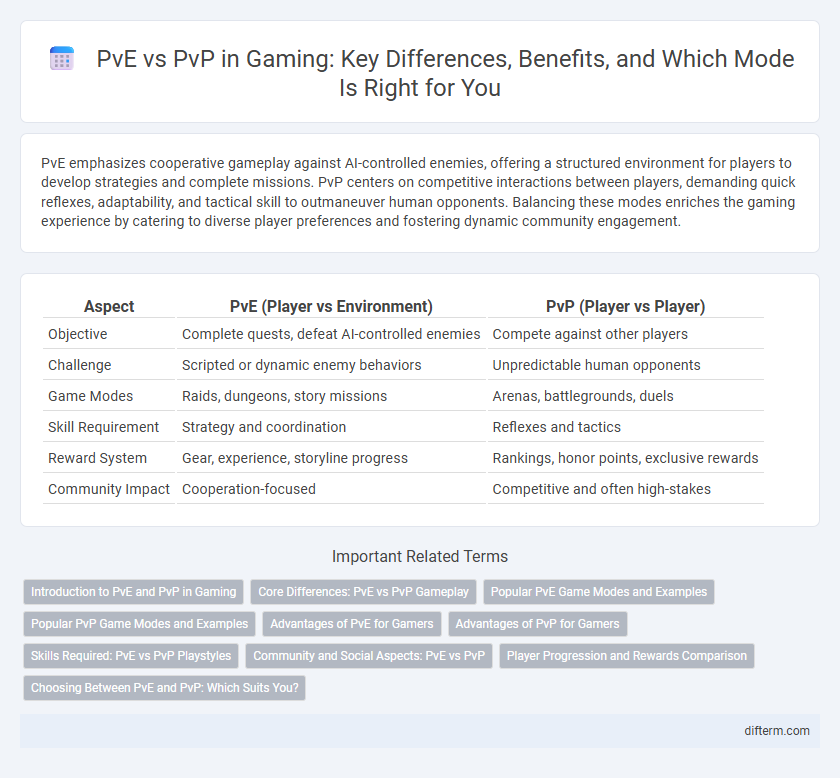PvE emphasizes cooperative gameplay against AI-controlled enemies, offering a structured environment for players to develop strategies and complete missions. PvP centers on competitive interactions between players, demanding quick reflexes, adaptability, and tactical skill to outmaneuver human opponents. Balancing these modes enriches the gaming experience by catering to diverse player preferences and fostering dynamic community engagement.
Table of Comparison
| Aspect | PvE (Player vs Environment) | PvP (Player vs Player) |
|---|---|---|
| Objective | Complete quests, defeat AI-controlled enemies | Compete against other players |
| Challenge | Scripted or dynamic enemy behaviors | Unpredictable human opponents |
| Game Modes | Raids, dungeons, story missions | Arenas, battlegrounds, duels |
| Skill Requirement | Strategy and coordination | Reflexes and tactics |
| Reward System | Gear, experience, storyline progress | Rankings, honor points, exclusive rewards |
| Community Impact | Cooperation-focused | Competitive and often high-stakes |
Introduction to PvE and PvP in Gaming
Player versus Environment (PvE) in gaming involves players cooperating or competing against computer-controlled enemies, focusing on story-driven missions, skill progression, and cooperative gameplay. Player versus Player (PvP) emphasizes direct competition between players, testing individual skill, strategy, and reaction times in various game modes such as duels, arenas, and large-scale battles. Understanding the dynamics of PvE and PvP is essential for gamers seeking to optimize their gameplay style and experience diverse challenges within multiplayer environments.
Core Differences: PvE vs PvP Gameplay
PvE gameplay centers on cooperative or solo experiences against computer-controlled enemies, emphasizing strategy and story progression. PvP gameplay involves direct competition between players, focusing on skill, reflexes, and real-time tactics. These core differences shape player interaction, objectives, and overall game dynamics in the gaming environment.
Popular PvE Game Modes and Examples
Popular PvE game modes include raid battles, dungeon crawls, and story-driven quests, each offering cooperative challenges against AI-controlled enemies. Titles like World of Warcraft feature extensive raid systems where players collaborate to defeat powerful bosses, while games like Destiny 2 emphasize narrative-driven missions combined with intense PvE combat. These modes attract players seeking immersive experiences and teamwork in battling computer-generated adversaries.
Popular PvP Game Modes and Examples
Popular PvP game modes include Battle Royale, Team Deathmatch, and Capture the Flag, each offering unique competitive experiences. Notable examples are Fortnite for Battle Royale, Call of Duty: Warzone for Team Deathmatch, and Overwatch for Capture the Flag, attracting millions of players worldwide. These modes emphasize player skill and strategy, driving community engagement and esports tournaments.
Advantages of PvE for Gamers
PvE (Player versus Environment) offers gamers a more immersive experience by enabling cooperative gameplay against AI-controlled enemies, fostering teamwork and strategy development. It typically provides a structured progression system through quests and storylines, enhancing player engagement and skill improvement. PvE also reduces competitive pressure, making it ideal for casual gamers seeking a relaxed and narrative-driven gaming environment.
Advantages of PvP for Gamers
PvP offers gamers intense competitive challenges that enhance reflexes and strategic thinking through real-time player battles. It fosters a dynamic community environment where players can test skills, adapt tactics, and experience unpredictable gameplay scenarios. This competitive aspect drives skill improvement and provides a sense of accomplishment unmatched by AI-driven PvE encounters.
Skills Required: PvE vs PvP Playstyles
PvE gameplay emphasizes strategic planning, resource management, and teamwork to overcome AI-controlled enemies, requiring patience and adaptability. PvP demands quick reflexes, precise timing, and advanced knowledge of opponents' tactics to succeed in dynamic, unpredictable scenarios. Mastery in both modes involves honing distinct skill sets tailored to cooperative versus competitive challenges.
Community and Social Aspects: PvE vs PvP
PvE fosters cooperative gameplay that strengthens community bonds through teamwork, shared goals, and collaborative strategies, enhancing social interaction within guilds and clans. PvP emphasizes competitive engagement, driving player rivalry and dynamic social hierarchies while encouraging skill development and strategic alliances. Both modes cultivate distinct social environments that shape player experiences and community dynamics in multiplayer games.
Player Progression and Rewards Comparison
PvE (Player vs Environment) offers structured quests and challenges that facilitate steady character progression through experience points, loot acquisition, and skill development tailored to overcoming AI-controlled enemies. PvP (Player vs Player) emphasizes competitive progression where rewards often include ranked titles, exclusive gear, and in-game currency earned by defeating other players, promoting strategic skill improvement and adaptability. Both modes provide unique pathways for player growth, with PvE focusing on narrative-driven advancement and consistent resource gains, while PvP centers on skill mastery and dynamic reward systems driven by player competition.
Choosing Between PvE and PvP: Which Suits You?
Choosing between PvE and PvP depends on your preferred gameplay style and objectives. PvE offers immersive story-driven quests and cooperative challenges against AI, ideal for players who enjoy exploration and teamwork. PvP focuses on competitive battles against other players, appealing to those seeking fast-paced, skill-based combat and ranking systems.
PvE vs PvP Infographic

 difterm.com
difterm.com